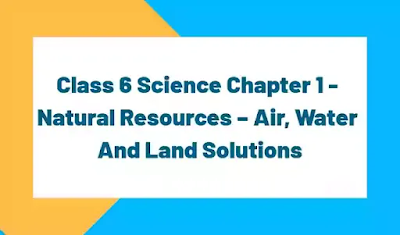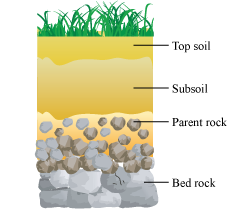Class 6 Science Chapter 1 – Natural Resources – Air, Water and Land Solutions
Maharashtra state board science Textbook Solutions for Class 6 are very important and crucial that help the students in understanding complex topics. Class 6 Science textbook solutions help you in the preparation for the class 6 science board examination as well as various competitive entrance examinations also. Studying the class 6 science answers to the questions in the science textbook will check your understanding of a particular topic and helps you determine your strengths and weaknesses.

We provide step-by-step Class 6 Science Chapter 1 – Natural Resources – Air Water and Land Solutions that help you understand and learn how to solve for the answer. Comprehending how to calculate the answer is where true learning begins. Armed with this knowledge, you can apply it to other textbook problems and be better prepared to succeed on test day / Board exam day of class 6 science. Plus, we regularly update and improve Class 6 Science Textbook Solutions based on student ratings and feedback, so you can be sure you’re getting the latest information available.
Important points
- The elements available in nature which fulfill the basic needs of living things are called natural resources.
- Air, water, and land are important natural resources.
- Soil has both biotic and abiotic constituents.
- There are many constituents of air such as nitrogen, oxygen, carbon dioxide, inert gases, water vapor, and dust particles.
- The ozone layer is a protective shell of the earth.
- Natural resources should be used carefully and sparingly
Class 6 Science Chapter 1 – Natural Resources – Air, Water and Land Solutions
1. Fill in the Blank
a) The layer of ozone gas absorbs ultraviolet rays that come from the sun to the earth.
b) Of the total water available on the earth, fresh water forms 0.3 percent.
c) Both biotic and abiotic constituents are present in the soil.
2. Why is it said that –?
a) The ozone layer is a protective shell of the earth.
Answer: Because the ozone layer absorbs the harmful ultraviolet rays that come from the sun to the earth.
b) Water is life.
Answer: Because without water we can not function properly, our metabolism is dependent on water, and we can not survive without water
c) Seawater is useful even though it is not potable.
Answer: because Seawater supports a vast quantity of marine life that serves as food for us. The plant life of the sea, commonly known as phytoplankton, recycles oxygen for you and I to breathe. Seawater also moderates our climate.
3. What will happen if –
a) Microbes in the soil get destroyed.
Answer: If all the microbes in the soil get destroyed, then all the soil respiration and soil nutrient cycling will be stopped. The soil loses its nutrients and hence the plants will not get any nutrients from the soil. And there will be no plants on Earth as they will not get any nutrients and hence Earth will be destroyed
b) The number of vehicles and factories in your surroundings increases.
Answer: The increase in the number of vehicles and factories in the surroundings will give rise to employment for many people. But at the same time, they will pose a threat to the entire environment. There will be more emission of carbon dioxide and other harmful gases that will lead to heart and lung issues.
c) The total supply of potable water is finished.
Answer: If the potable water will finish then Non-potable water can be made potable through reverse osmosis or steam distillation, among other methods. The only problem is that these methods are generally expensive and energy intensive, so energy prices (not to mention water prices) would inevitably soar.
4. Match the following
Group ‘A’ Group ‘B’
1) Carbon a) Generation of dioxide soil
2) Oxygen b) Rain
3) Water c) Plants and vapor food production
4) Microbes d) Combustion
Answer: 1-c. 2-d. 3-b. 4-a
Q.5 Name the following
a) Constituents of the biosphere
Answer: It consists of three components Lithosphere (Land), Hydrosphere (Water) and Atmosphere (Air).
b) Biotic constituents of soil
Answer: Biotic factors are living or once-living organisms in the ecosystem. These are obtained from the biosphere and are capable of reproduction. Examples of biotic factors are animals, birds, plants, fungi, and other similar organisms
c) Fossil fuel
Answer: Fossil fuel is a fuel formed by natural processes, such as the anaerobic decomposition of buried dead organisms, containing energy originating in ancient photosynthesis. Such organisms and their resulting fossil fuels typically have an age of millions of years, and sometimes more than 650 million years.
d) Inert gases in the air
Answer: There are many gases that make up our atmosphere, including inert gases. When we refer to inert gases, we are usually referring to six primary ones, also called noble gases. Meet the most common inert gases: helium (He), argon (Ar), neon (Ne), krypton (Kr), xenon (Xe), and radon (Rn)
e) Gases that are harmful to the ozone layer.
Answer: Chlorofluorocarbons (CFCs) and other halogenated ozone-depleting substances (ODS) are mainly responsible for man-made chemical ozone depletion.
6. True or false?
a) Land and soil are the same thing.
Answer: False
b) The water in a lake is called groundwater.
Answer: True
c) It takes about 1000 years to form a 25 cm thick layer of soil.
Answer: False
d) Radon is used in decorative lights.
Answer: True
7. Answer in your own words
a) Explain with the help of a diagram how soil is formed.
Answer: The soil is formed over millions of years. The soil is made up of very small particles. the soil is a thin layer of material covering the earth’s surface and is formed from the weathering of rocks. it is made up mainly of mineral particles, organic materials, air, water, and living organisms.

b) Why is there a shortage of water even though it occupies about 71% of the earth’s surface?
Answer: Because 71 % is in the form of salty water present in oceans and seas. so It cannot be utilized for daily purposes like bathing, drinking, etc. water. out of that 3%, 2% is the form of glaciers so.
c) What are the various constituents of air? Write their uses.
Answer: The various air constituents are- Nitrogen, Oxygen, Carbon Dioxide, and argon. Now these constituents are denoted by a pie chart where Nitrogen Is 78% and Oxygen is 21%. The 1% includes Various gases with carbon dioxide and argon being the most abundant of them.
Importance of air:
1) The importance of air can be understood by the fact that Earth supports life because of the presence of this air in our surroundings.
2) It is required for various biological functions and biogeochemical cycles.
d) Why are air, water, and land considered to be valuable natural resources?
Answer: Air, water, and land are considered to be valuable natural resources because they cannot be reconstructed by human beings if they are exhausted or polluted. These natural resources are limited and should be very carefully maintained for the goodness and well-being of living organisms on Earth.
Importance of land:
1) All terrestrial organisms live on land.
2) We use it for the purpose of land farming, building houses, roads, etc.
3) The plants and animals which we use also grow on the land.
4) The minerals which we obtain from deep inside the earth are also important resources. For example, petrol, coal, etc.
#Observe the picture alongside and answer the questions.
1. Where do we see the birds?
Answer: in Air
2. Where is the cow grazing?
Answer: on land
3. Locate the trees and the road.
Answer: —–
4. Where does the river come from? How does it flow?
Answer: From Mountains & It flows smoothly.
5. Where is the airplane?
Answer: In the sky.
6. Where are the fish seen?
Answer: In the water.
7. On what is the sailboat floating?
Answer: water
# Use your brain power :
1. What would have happened if there were no air on the earth?
Answer: If there was no air on earth, plants and animals would not survive. The latter use oxygen for respiration, therefore they will not get the necessary fuel for the breakdown of the food products. Moreover, the ultraviolet rays will fall on earth and cause untold destruction because the atmosphere will lack an ozone layer.
2. In what ways is the water in seas and oceans useful even though it is salty?
Answer: The Sea and ocean waters, even if is salty, is useful in the following ways: a) The salts can be separated and the water in the seas and oceans can be used for drinking purposes. b) The salt can be extracted and purified to make edible salts.
3. What are the constituents of soil? Classify them as biotic and abiotic constituents.
Answer: soil is made up of four constituents: mineral material, organic material, air, and water. There are considered to be three main mineral parts to soil; ‘sand’, ‘silt’, and ‘clay’. These parts give the soil its ‘mineral texture’. Abiotic and Biotic: Abiotic factors refer to non-living physical and chemical elements in the ecosystem. Abiotic resources are usually obtained from the lithosphere, atmosphere, and hydrosphere. Examples of abiotic factors are water, air, soil, sunlight, and minerals. Biotic factors are living or once-living organisms in the ecosystem. These are obtained from the biosphere and are capable of reproduction. Examples of biotic factors are animals, birds, plants, fungi, and other similar organisms.
# Can you tell
1. What is land made of?
Answer: Earth is made up of land, air, water, and life. Mountains, valleys, and flat places make up the land.
2. Is the land flat everywhere?
Answer: No
3. What do you see on land?
Answer: All things are on land like trees, grasses, animals, and plants.
4. Does man produce soil/land?
Answer: No
5. What has man created on land?
Answer: Houses, buildings.
6. If a deep pit is dug in the ground, what do you find there?
Answer: If you drill a large hole in the ground, it is possible to find soil and also water when the depth increases to a great extent. One of the most important aspects of the pit is that it should dig deeper to get the desired results in an impeccable manner.
